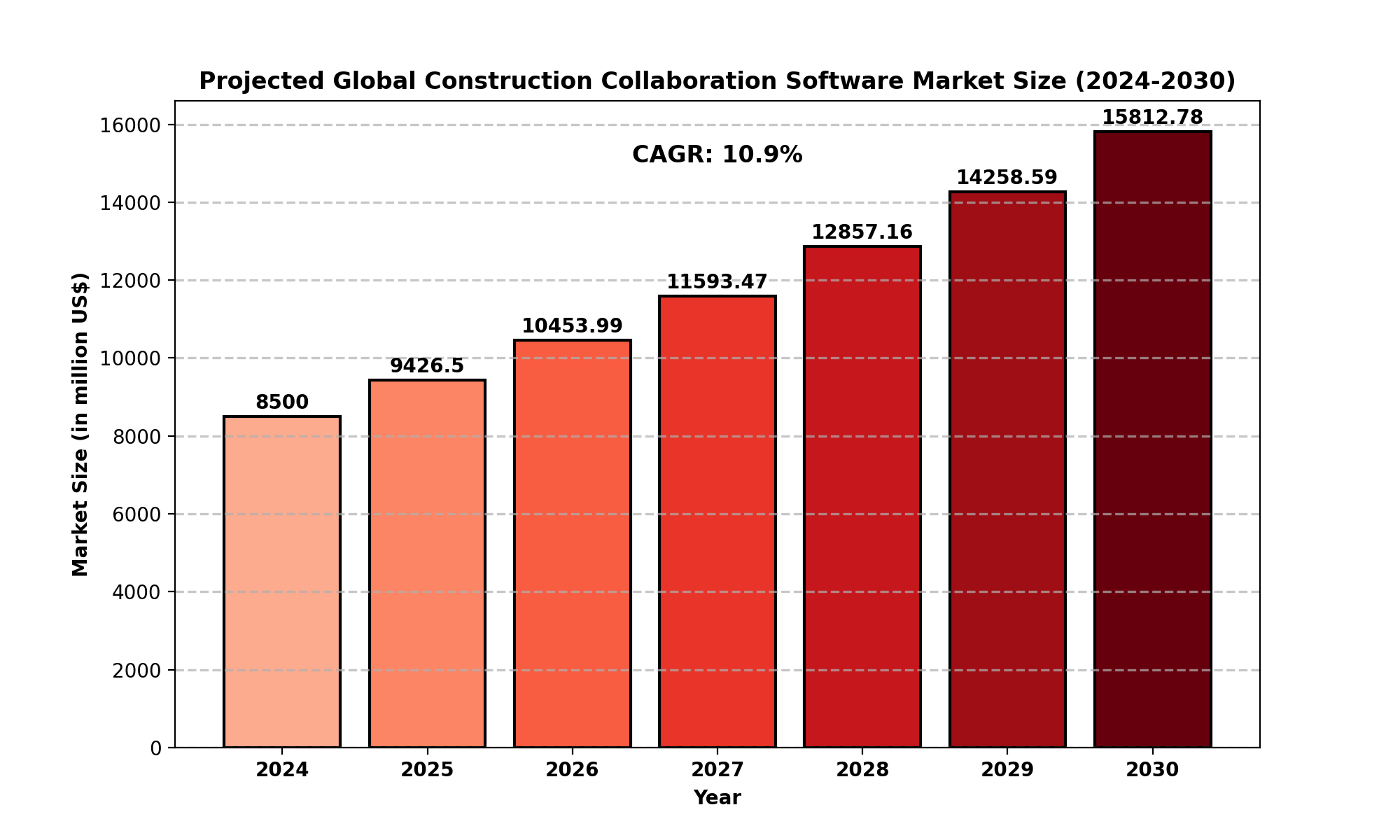TOP CATEGORY: Chemicals & Materials | Life Sciences | Banking & Finance | ICT Media

Download Report PDF Instantly
Report overview
Construction Collaboration Software encompasses comprehensive digital platforms designed specifically for construction project management and team coordination. These solutions integrate project planning, document sharing, real-time communication, Building Information Modeling (BIM) collaboration, and workflow management tools. The technology supports multi-stakeholder collaboration across contractors, architects, engineers, and project owners, featuring mobile accessibility, version control, and advanced visualization capabilities tailored to construction-specific needs.
The global Construction Collaboration Software Market was valued at US$ 8.5 billion in 2024 and is projected to reach US$ 15.8 billion by 2030, growing at a CAGR of 10.9% during the forecast period.
The United States market, a key contributor, was valued at US$ 2.8 billion in 2024 and is forecasted to reach US$ 5.6 billion by 2030, with a higher CAGR of 12.2%.
Key statistics highlighting the market scope include:
52% adoption rate for project management features.
48% increase in BIM integration.
55% growth in mobile accessibility usage.
58% of deployments are cloud-based solutions.
Document control features expanded by 45%.
This rapid growth is fueled by the digital transformation within the construction industry, driving demand for tools that enhance efficiency and collaboration across diverse project teams.

Drivers
Digital Transformation in Construction:
Increasing adoption of cloud-based technologies and mobile tools to streamline workflows.
Enhanced efficiency through automation and real-time data sharing.
Demand for Improved Collaboration:
Growing project complexity necessitates better coordination among stakeholders.
Rising adoption of BIM tools for seamless design-to-construction workflows.
Cost Savings and Efficiency Gains:
Reduction in project delays and rework through effective planning and monitoring.
Enhanced decision-making with real-time project insights.
Restraints
High Initial Investment:
Cost barriers for small- to medium-sized construction firms.
Complexity in Integration:
Challenges in integrating with existing systems and tools.
Steep learning curve for employees unfamiliar with advanced technologies.
Opportunities
Emerging Markets:
Untapped potential in developing economies as construction activities surge.
Increasing government investments in infrastructure.
AI and Machine Learning Integration:
Predictive analytics to improve project outcomes.
Automation of routine tasks, allowing teams to focus on critical aspects.
Challenges
Cybersecurity Risks:
Growing reliance on digital platforms increases exposure to cyber threats.
User Adoption and Training:
Resistance to change among traditional construction teams.
Need for comprehensive training programs to boost adoption rates.
North America
Market Size: US$ 2.8 billion (2024), projected to reach US$ 5.6 billion by 2030.
Key Drivers:
Strong adoption of cloud-based solutions.
High investment in advanced construction technologies.
Europe
Market Trends:
Increasing use of BIM collaboration tools in the UK, Germany, and France.
Supportive regulations for sustainable construction practices.
Asia-Pacific
Growth Potential:
Rapid urbanization and infrastructure development in China and India.
Increasing adoption of mobile and cloud solutions.
Middle East and Africa
Market Highlights:
Rising construction activities fueled by mega-projects in the UAE and Saudi Arabia.
Growing demand for efficient project management tools.
South America
Key Trends:
Infrastructure modernization driving adoption of collaboration software.
Focus on cost-effective solutions for small construction firms.
Key Players
CMiC: Specializes in enterprise resource planning (ERP) solutions for construction.
GanttPRO: Renowned for its intuitive project scheduling tools.
Autodesk: A leader in BIM and construction software.
Oracle: Provides advanced cloud-based construction management platforms.
Glodon: Strong presence in the Asia-Pacific market with localized solutions.
These companies leverage strategic partnerships, product innovation, and customer-centric approaches to maintain competitive positioning.
Contractors
Focus on efficient resource allocation and project timelines.
Owners
Emphasis on real-time project tracking and cost control.
Managers
Tools for workflow optimization and performance monitoring.
Engineers & Architects
Integration of design tools and collaborative platforms for seamless workflows.
Others
Includes suppliers and other stakeholders involved in construction projects.
Cloud-Based
Represents 58% of deployments, offering scalability and remote access.
On-Premises
Preferred by firms prioritizing data security and control.
CMiC
GanttPRO
Sarcophagus Limited
Touchplan
STACK
Autodesk
Oracle
Bentley Systems
Jinshi Software
Glodon
Yonyou
North America: USA, Canada, Mexico.
Europe: Germany, UK, France, Russia, Italy, Rest of Europe.
Asia-Pacific: China, Japan, South Korea, India, Southeast Asia, Rest of Asia-Pacific.
South America: Brazil, Argentina, Columbia, Rest of South America.
Middle East and Africa: Saudi Arabia, UAE, Egypt, Nigeria, South Africa, Rest of MEA.
What is the current market size of the Construction Collaboration Software Market?
The market was valued at US$ 8.5 billion in 2024 and is projected to reach US$ 15.8 billion by 2030.
Which are the key companies operating in the Construction Collaboration Software Market?
Major players include Autodesk, Oracle, CMiC, GanttPRO, Glodon, and Bentley Systems.
What are the key growth drivers in the Construction Collaboration Software Market?
Key drivers include digital transformation in construction, increased adoption of BIM tools, and demand for improved project collaboration.
Which regions dominate the Construction Collaboration Software Market?
North America leads in market share, followed by Europe and the Asia-Pacific region.
What are the emerging trends in the Construction Collaboration Software Market?
Emerging trends include AI and machine learning integration, enhanced mobile accessibility, and cloud-based deployments.
Industry drivers, restraints, and opportunities covered in the study
Neutral perspective on the market performance
Recent industry trends and developments
Competitive landscape & strategies of key players
Potential & niche segments and regions exhibiting promising growth covered
Historical, current, and projected market size, in terms of value
In-depth analysis of the Construction Collaboration Software Market
Overview of the regional outlook of the Construction Collaboration Software Market:
Access to date statistics compiled by our researchers. These provide you with historical and forecast data, which is analyzed to tell you why your market is set to change
This enables you to anticipate market changes to remain ahead of your competitors
You will be able to copy data from the Excel spreadsheet straight into your marketing plans, business presentations, or other strategic documents
The concise analysis, clear graph, and table format will enable you to pinpoint the information you require quickly
Provision of market value (USD Billion) data for each segment and sub-segment
Indicates the region and segment that is expected to witness the fastest growth as well as to dominate the market
Analysis by geography highlighting the consumption of the product/service in the region as well as indicating the factors that are affecting the market within each region
Competitive landscape which incorporates the market ranking of the major players, along with new service/product launches, partnerships, business expansions, and acquisitions in the past five years of companies profiled
Extensive company profiles comprising of company overview, company insights, product benchmarking, and SWOT analysis for the major market players
The current as well as the future market outlook of the industry concerning recent developments which involve growth opportunities and drivers as well as challenges and restraints of both emerging as well as developed regions
Includes in-depth analysis of the market from various perspectives through Porter